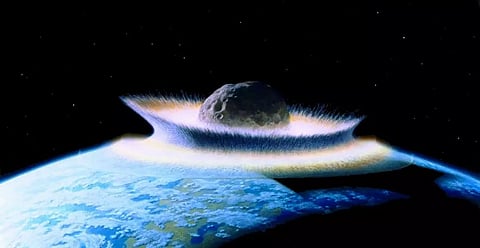
- Home
- Live Blog
- Breaking News
- Top Headlines
- Cities
- NE News
- Sentinel Media
- Sports
- Education
- Jobs

NEW YORK: While it is known that the devastating impact of something huge that crashed into Earth 66 million years ago led to the extinction of dinosaurs, clarity on whether it was a comet or asteroid strike and where it originated was lacking. Clearing the confusion, a new theory suggests that long-period comets originating from the Oort cloud, an icy sphere of debris at the edge of the solar system, could be behind the crash.
"Our paper provides a basis for explaining the occurrence of this event," said Avi Loeb from Harvard University. The Chicxulubimpactor, as it is known, left behind a crater off the coast of Mexico that spans 93 miles and runs 12 miles deep. Its devastating impact brought the reign of the dinosaurs to an abrupt and calamitous end by triggering their sudden mass extinction, along with the end of almost three-quarters of the plant and animal species living on Earth.
In the study, the researchers put forth a new theory that could explain the origin and journey of this catastrophic object.
"The solar system acts as a kind of pinball machine," explained Amir Siraj from Harvard University. "Jupiter, the most massive planet, kicks incoming long-period comets into orbits that bring them very close to the Sun."
During close passage to the Sun, the comets — nicknamed "sungrazers" — can experience powerful tidal forces that break apart pieces of the rock and ultimately, produce cometary shrapnel.
"In a sungrazing event, the portion of the comet closer to the sun feels a stronger gravitational pull than the part that is further, resulting in a tidal force across the object," Siraj said.
The new calculations from Siraj and Loeb's theory increase the chances of long-period comets impacting Earth by a factor of about 10, and show that about 20 percent of long-period comets become sungrazers.
The pair say that their new rate of impact is consistent with the age of Chicxulub, providing a satisfactory explanation for its origin and other impactors like it.
Evidence found at the Chicxulub crater suggests the rock was composed of carbonaceous chondrite. Siraj and Loeb's hypothesis might also explain this unusual composition.
A popular theory on the origin of Chicxulub claims that the impactor originated from the main belt, which is an asteroid population between the orbit of Jupiter and Mars. However, carbonaceous chondrites are rare amongst main-belt asteroids, but possibly widespread amongst long-period comets, providing additional support to the cometary impact hypothesis. (IANS)